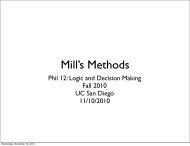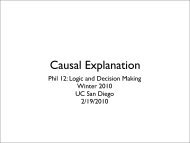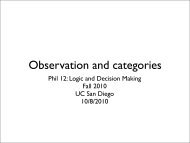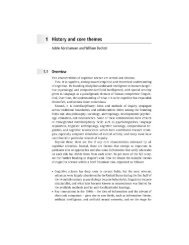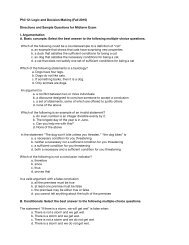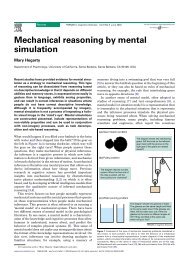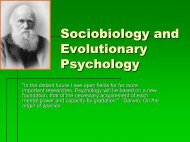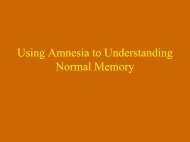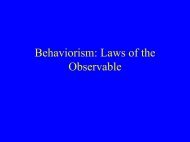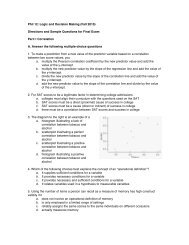Midterm Exam
Midterm Exam
Midterm Exam
Create successful ePaper yourself
Turn your PDF publications into a flip-book with our unique Google optimized e-Paper software.
Phil 12<br />
Fall, 2012<br />
I. Logic and the Basics of Scientific Reasoning<br />
Directions and Sample Questions for First <strong>Exam</strong><br />
A. Basic concepts: Select the best answer to the following multiple choice questions about basic<br />
concepts of logic and scientific reasoning as used in this course (10 points)<br />
1. Which of the following statements is true?<br />
a. The term hypothesis connotes degree of belief in a conjecture. Unlike the term theory, which<br />
refers to a conjecture that is widely accepted, a hypothesis is a conjecture that is generally<br />
rejected<br />
b. Once a hypothesis is referred to as a law, it becomes significantly less likely to be rejected as<br />
more evidence is gathered<br />
c. A hypothesis is a conjecture that is formulated prior to performing an experiment. Once an<br />
experiment has been formed, a hypothesis becomes a theory<br />
d. A hypothesis typically goes beyond reporting what can be observed to propose an explanation<br />
for the observations<br />
2. Which of the following could be a counterexample to a definition of dog<br />
a. an example that shows that dogs have surprising new properties<br />
b. a turkey that satisfies the sufficient conditions for being a dog<br />
c. a cat that satisfies the necessary conditions for being a dog.<br />
d. a dog that does not satisfy one set of sufficient conditions for being a dog<br />
3. Which of the following is a contradiction?<br />
a. I like physics, but I am not good at it.<br />
b. I like physics, but I do not like any sciences.<br />
c. I like physics, but I do not like mathematics.<br />
d. I like physics, but I am a philosophy major.<br />
4. Which of the following is a tautology?<br />
a. Human beings are mortal.<br />
b. Codex is a monkey and Kwan is a StarCraft world champion.<br />
c. If Clara is either tall or not tall, then she both is and is not a frost mage.<br />
d. If Zaboo is a warlock, then Vork either is a warrior or Vork is not a warrior.<br />
5. Which of the following is a counterexample to the definition of a box as a rigid container with a cover?<br />
a. a box that is not rigid<br />
b. a covered container that is not rigid<br />
c. a covered container that is not a box<br />
d. something rigid that is not a box<br />
6. Which of the following is an example of a valid statement?<br />
a. A bachelor is an unmarried male.<br />
b. The longest day of the year is in June.<br />
c. Can you help me with this?<br />
d. None of the above
Phil 12 Fall 2012 Sample First <strong>Exam</strong> p. 2<br />
7. Which of the following statements is true?<br />
a. A valid argument cannot have false premises and a false conclusion<br />
b. A valid argument cannot have a false conclusion<br />
c. A valid argument must have true premises and a true conclusion<br />
d. A valid argument may have false premises and a true conclusion<br />
8. In the statement “The dog won’t bite unless you threaten” “the dog bites” is<br />
a. a necessary condition for you threatening<br />
b. neither a necessary nor a sufficient condition for you threatening<br />
c. a sufficient condition for you threatening<br />
d. both a necessary and a sufficient condition for you threatening<br />
9. Which of the following is not a conclusion indicator?<br />
a. therefore<br />
b. since<br />
c. thus<br />
d. proves that<br />
10. In a valid argument with a false conclusion<br />
a. all the premises must be true<br />
b. at least one premise must be false<br />
c. the premises may be either true or false<br />
d. you cannot tell anything about the truth of the premises<br />
B. Conditionals: Select the best answer to the following multiple-choice questions about conditional<br />
statements. (15 points)<br />
1. The statement “If there is a storm or the sprinklers are on, then we will get wet” is false when:<br />
a. There is not a storm and the sprinklers are not on, yet we get wet.<br />
b. The sprinklers are on and we get wet.<br />
c. There is not a storm and the sprinklers are not on, and we do not get wet.<br />
d. There is a storm and we do not get wet.<br />
2. “Only if you follow the directions will you pass the exam” is logically equivalent to which of the<br />
following statements?<br />
a. If you follow the directions, then you will pass the exam<br />
b. You will pass the exam if you follow the directions<br />
c. If you pass the exam, then you followed the directions<br />
d. Unless you passed the exam, then you followed the directions<br />
3. The statement “Only if you follow the directions will you pass the exam” is false when<br />
a. You followed the directions and passed the exam<br />
b. You followed the directions and did not pass the exam<br />
c. You did not follow the directions and passed the exam<br />
d. You did not follow the directions and did not pass the exam<br />
4. Which of the following is true of the statement “Only if a miracle occurs will Joe pass the class”?<br />
a. The occurrence of a miracle is a sufficient condition for Joe’s passing the class<br />
b. It is false when Joe passes the class and a miracle does occur<br />
c. It is logically equivalent to the statement “Unless Joe passes the class, a miracle will not occur<br />
d. None of the above
Phil 12 Fall 2012 Sample First <strong>Exam</strong> p. 3<br />
5. The statement “They will die unless a cure is found” is logically equivalent to which of the following<br />
a. If they do not die, then a cure was found<br />
b. If a cure is found, then they will not die<br />
c. If they die, then a cure was not found<br />
d. Only if a cure was not found will they die<br />
C. Conditional arguments: Identify the form of each of the following conditional arguments AND<br />
whether it is valid or not. Both parts must be correct to get credit for the question (15 points)<br />
1. If Juan knows about Mendelian inheritance, he is a biology major. Juan does not know about<br />
Mendelian inheritance. Therefore, he is not a biology major.<br />
a. Modus ponens b. Modus tollens<br />
c. Affirming the consequent d. Denying the antecedent<br />
e. Valid f. Invalid<br />
2. If there is still fruit on the plate, it is poisoned. But there is no fruit on the plate. Therefore it is not<br />
poisoned.<br />
a. Modus ponens b. Modus tollens<br />
c. Affirming the consequent d. Denying the antecedent<br />
e. Valid f. Invalid<br />
3. If Link did not possess the triforce then he couldn't have beaten Gannon. But clearly he did beat<br />
Gannon. Thus, it follows that Link possessed the triforce.<br />
a. Modus ponens b. Modus tollens<br />
c. Affirming the consequent d. Denying the antecedent<br />
e. Valid f. Invalid<br />
4. The defendant is not guilty because she is smiling and if she were guilty she would not be smiling.<br />
a. Modus ponens b. Modus tollens<br />
c. Affirming the consequent d. Denying the antecedent<br />
e. Valid f. Invalid<br />
5. There will be more traffic accidents in the future. We know this because the number of drivers is<br />
increasing, and if the number of drivers increases, there will be more traffic accidents.<br />
a. Modus ponens b. Modus tollens<br />
c. Affirming the consequent d. Denying the antecedent<br />
e. Valid f. Invalid
Phil 12 Fall 2012 Sample First <strong>Exam</strong> p. 4<br />
D. Logic and Evidential Relations: Answer the following questions about the logical relations<br />
involved in evaluating hypotheses. (15 points)<br />
Consider the following hypothesis, prediction, and argument:<br />
Hypothesis: Human beings are the product of evolution.<br />
Prediction: The human visual system does not have a blind spot.<br />
Argument:<br />
If human beings are the product of evolution, then the human visual system does not have a<br />
blind spot.<br />
The human visual system does contain a blind spot.<br />
Therefore, Evolution is false.<br />
For each of the following strategies, explain why it either is or is not a good strategy for challenging the<br />
argument and identify which is the best to use<br />
Strategy #1: Challenge the validity of the argument<br />
Strategy #2: Challenge the claim that the human visual system contains a blind spot<br />
Strategy #3: Challenge the first premise<br />
II. Observation<br />
A. Observation, Categorization, and Taxonomy: Answer the following questions about observation,<br />
categorization, and taxonomy in a short paragraph. (15 points)<br />
1. What aspect of perception is illustrated by the drawing on the left? What<br />
challenge does this pose to scientists? Explain in some detail.<br />
2. Most native Japanese speakers who have grown up in Japan cannot distinguish<br />
between the “l” sound and the “r” sound. How might the fact that neither sound<br />
appears in Japanese explain this fact? How, nonetheless, might your roommate, a<br />
native Japanese speaker who grew up in Japan appear to distinguish perfectly between these letters in<br />
words you use in conversation with her?<br />
2. Why is it important to plan carefully the coding system that will be used in an observational study?<br />
What can go wrong if one has a poorly designed coding system?<br />
B. Basic concepts: Select the best answer to the following multiple-choice questions about terms<br />
used to describe features of observational research, including variables and their measurement. (10<br />
points)<br />
1. For classifying furniture, the categories dining table, desk chair, sofa, lamp, are<br />
a. exhaustive and exclusive<br />
b. exhaustive but not exclusive<br />
c. exclusive but not exhaustive<br />
d. neither exclusive nor exhaustive<br />
2. Jane Goodall’s decision to use binoculars in her research on chimpanzees in Gombe National Park<br />
presumably reflected her concern with:<br />
a. reliability<br />
b. reactivity<br />
c. observer bias<br />
d. artifactual results
Phil 12 Fall 2012 Sample First <strong>Exam</strong> p. 5<br />
3. When a nominal variable is expressed in terms of numbers, it uses the numbers<br />
a. only as names<br />
b. to specify rank ordering<br />
c. to quantify differences between items<br />
d. to specify ratios between items<br />
4. The reactivity bias involves<br />
a. researchers becoming upset with the participants in the study<br />
b. participants in a study altering their behavior as a result of being observed<br />
c. participants in a study becoming upset with the researchers and destroying the study<br />
d. researchers’ reports being influenced by their expectations<br />
5. When the American Podiatrist Association evaluates its members as highly qualified, qualified, and<br />
unqualified, it is employing:<br />
a. a nominal variable<br />
b. an ordinal variable<br />
c. an interval variable<br />
d. a ratio variable<br />
C. Observational research, variables, and measurement: Select the best answer to the following<br />
multiple-choice questions. (20 points)<br />
1. In naturalistic observational research, which of the following should not occur<br />
a. observation is performed indoors<br />
b. the observer manipulates events<br />
c. a video record is made of the event<br />
d. behavior is coded into categories<br />
2. Which of the following is not true?<br />
a. One is performing time sampling if one records data from every third sale at a store<br />
b. One is performing event sampling if one records data from every 10 th person to check a book<br />
out at the library<br />
c. One is performing time sampling if one records traffic conditions every 10 minutes<br />
d. One is performing situation sampling if one records events at different coffee shops<br />
3. Which of the following is a measure of central tendency?<br />
a. standard deviation<br />
b. variance<br />
c. range<br />
d. mode<br />
4. Which of the following is not true?<br />
a. In some distributions, the mode is larger than the median<br />
b. In some distributions, the median is larger than the arithmetic mean<br />
c. In some distributions, the arithmetic mean is larger than the standard deviations<br />
d. In some distributions, the standard deviation is larger than the variance
Phil 12 Fall 2012 Sample First <strong>Exam</strong> p. 6<br />
5. Which of the following is true of a normal distribution?<br />
a. The scores are equally distributed across the range<br />
b. There are fewer scores further from the peak<br />
c. The peaks are equally distributed across the range<br />
d. There are more scores further from the peak<br />
6. If the distribution is normal, what percent of scores lie within 2 standard deviations of the mean?<br />
a. 50%<br />
b. 68%<br />
c. 95%<br />
d. 99%<br />
7. In order to estimate how close the mean of the actual population is to the mean of a sample, one needs<br />
to know<br />
a. the median of the sample<br />
b. the standard deviation of the actual population<br />
c. the standard deviation of the sample<br />
d. what percentage of the population was actually sampled<br />
The following questions are based on this scenario:<br />
How much of their awake time do marmots spend eating? To answer this question, a researcher<br />
videotaped several hours of marmot behavior from an inconspicuous location and then arranged<br />
for students to code the marmot behavior into a number of exclusive and exhaustive categories,<br />
identifying for each moment which behavior the marmot was exhibiting.<br />
8. The investigator in this study was<br />
a. a participant observer<br />
b. conducting an experiment<br />
c. engaging in structured observation<br />
d. engaging in naturalistic observation<br />
9. The length of time spent eating is a<br />
a. nominal variable<br />
b. ordinal variable<br />
c. interval variable<br />
d. ratio variable<br />
10. If in the sample observations the mean number of minutes eating per hour during the observation<br />
period was 16 minutes and the standard deviation was 4 minutes, then<br />
a. with 68% confidence, the mean in the sample is between 12 and 20 minutes<br />
b. with 68% confidence, the mean of the actual population is between 8 and 24 minutes<br />
b. with 95% confidence, the mean of the actual population is between 8 and 24 minutes<br />
c. with 95% confidence, the mean of the actual population is between 12 and 20 minutes



